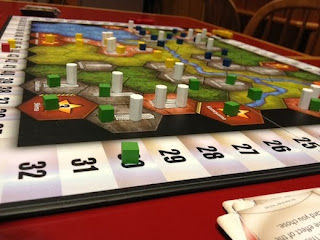In my continuing efforts to try out every awesome sounding dexterity game that comes along, I've unsurprisingly hunted down a copy of Riff Raff!
In Riff Raff, each player has a pile of miscellaneous pieces that he is trying to stack on a boat. Sound easy? Well... the boat is leaning. And, you have to place your pieces on certain sections. Specifically, each player is given a hand of cards ranging from 1-10, which correspond to the different parts of the ship (four on the lower part, and six on the masts). Each card can only be used once (hence the game can only last up to ten rounds). To start each turn, all players reveal a card. Whoever plays the highest card gets to place a piece on the ship first (in that section), followed by the other players in order. Players cannot touch the ship or previously placed pieces directly, but are allowed to bump them with their current piece. If a piece is successfully placed on the boat, with nothing falling off, great! If pieces fall off, then the active player can attempt to catch them. Any pieces that are caught are removed from the game - and any fallen pieces that were not caught are added to that player's supply. The first person to run out of pieces wins the game! (Alternately, if nobody is very good (which happens regularly), whoever has the least number of pieces after the tenth round is the winner.)
 |
| Crewmen holding on for dear life! |
The next pro for Riff Raff is that I the components are very well made. This is not something that I generally care much about, but in a dexterity game, it can be critical. And, more specifically, the components for Riff Raff are very well made for the design of the game. It's not "hey, this is a good piece of cardboard," but it is "this piece makes the game play better." The main piece that I'm thinking of is the ship, and it's balancer. The box has a cardboard insert that folds up and sits on top of the plastic insert. The ship sits on top of this (on a wooden ring), but the ship has a large wooden piece with a metal ball attached to the bottom of it. This metal ball is what causes the ship to lean every direction imaginable without toppling over. No matter how many of your pieces you set on the top ledge of the ship, it will not topple, because it is weighted well. So, as I said - the pieces being made well enhances the game, instead of simply being a nice cosmetic aspect.
There are some elements of the game that I'm going to mention that aren't really pros or cons. One of them is that in my copy of the game, the boat is often leaning from the beginning. It doesn't really lean very far (maybe 10 degrees), and if you mess with it enough, you can get it to lean even less than that. I can't decide if this is something wrong with my copy, and it really should stand up straight to start the game, or if this was something intentional to make sure that the game is challenging from the beginning. And if it is something "wrong" with my copy, I haven't decided if it makes my copy better or worse.
 |
| A mostly empty boat |
My only real con for Riff Raff is that I dislike the rule about catching pieces. Or, more specifically, I dislike that you can catch the piece that you are currently placing, and it goes out of the game. It is far too easy to balance it for half of a second, and then as it falls, catch it. And catching it that way is almost as good as playing it! (I say almost, because it is still better to play a piece so that there are more pieces for the next player to potentially knock off.) I think that this can be fixed with house rules - either everyone has to play with just one hand, or the current piece cannot be caught, or something of that nature. However, whenever I feel the need to make a house rule, I am disappointed.
Overall, I give Riff Raff an 8.5/10. It is a fun game with amazing components, and the designers have managed to find something unique within the dexterity genre, for which I applaud them.
If Riff Raff sounds interesting, you should also check out Crokinole, Hamsterrolle, and Catacombs.









